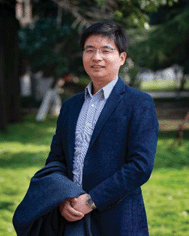Nanoscale & Nanoscale Advances joint themed collection on halide perovskite nanocrystals
Lakshminarayana
Polavarapu
 *a,
Qiao
Zhang
*a,
Qiao
Zhang
 *b and
Roman
Krahne
*b and
Roman
Krahne
 *c
*c
aChair for Photonics and Optoelectronics, Nano-Institute Munich, Department of Physics, Ludwig-Maximilians-Universität (LMU), Königinstr. 10, 80539 Munich, Germany. E-mail: l.polavarapu@lmu.de
bInstitute of Functional Nano and Soft Materials (FUNSOM), Jiangsu Key Laboratory for Carbon-Based Functional Materials and Devices, Soochow University, China. E-mail: qiaozhang@suda.edu.cn
cIstituto Italiano di Tecnologia, Via Morego 30, 16163 Genova, Italy. E-mail: Roman.Krahne@iit.it
Colloidal semiconductor nanocrystals (NCs), also known as colloidal quantum dots (QDs) have played an indispensable role in the development of modern nanoscience and nanotechnology because of their unique optical and electronic properties, and they are still being intensively investigated for various potential applications. Semiconductor NCs offer significant advantages over conventional organic fluorescent dyes, including the tunability of emission color by their size and composition, excellent color purity, ease of preparation and controllable surface chemistry enabling their dispersion in various solvents for solution processability. As a consequence, the past two decades have witnessed tremendous progress in the shape-controlled synthesis, self-assembly, surface functionalization and optoelectronic device applications of II–VI and III–V semiconductor QDs.
Recently, metal halide perovskites have emerged as a new class of semiconductor material with extraordinary optical and electronic properties. Perovskite materials of the form APbX3 (with A as the inorganic or organic cation, and X = Cl, Br, or I) have been well known since the late 1970s from the work by Weber.1 They became popular after the first report on halide perovskite solar cells in 2009 by Kojima et al.2 Since then, halide perovskites have created large excitement in the photovoltaic research community that was stimulated by a meteoric rise in the power conversion efficiency of perovskite solar cells from 3.8% to over 22% in a short development time. In addition, the outstanding optical properties of perovskites have made them excellent light sources for applications in LEDs, photodetectors, photo transistors and lasers. The early studies on perovskites were focused on the optimization of bulk films for device applications. Despite the rapid progress in perovskite materials in photovoltaics and optoelectronics, the properties that make them so special, like their tolerance to defects, are yet to be fully understood.
From the II–VI and III–V semiconductor materials, we know that colloidal nanocrystals offer several advantages over their bulk counterparts, including solution processability, enhanced photoluminescence efficiency and tunable emission through quantum confinement effects. The first solution phase colloidal synthesis of organic–inorganic hybrid perovskite NCs was published in 2014 by Pérez-Prieto et al.3 A year later, Kovalenko et al.4 reported the colloidal synthesis of all-inorganic perovskite NCs. Since then, metal halide perovskite NCs have received significant research interest due to their extraordinary optical properties as well as their appeal as emitters in efficient light sources.
The unique feature of perovskite NCs is that they exhibit near unity photoluminescence quantum yield (PLQY) without the need of a core–shell architecture, unlike the conventional QDs (e.g. CdSe/CdS/ZnS and CdSe/ZnSe/ZnS core-multi shell NCs). The emission color of perovskite NCs is easily tunable across the visible spectrum by the halide composition and by confinement effects. Like in conventional colloidal systems, ligands play a crucial role in the shape and size control of perovskite NCs, and also in the passivation of surface defects, which is decisive for high PLQY.5 In the last few years, we have witnessed extremely rapid progress in the synthesis of perovskite NCs of a wide range of morphologies and shapes, such as quantum dots, nanocubes, nanowires, nanorods, nanoplatelets, and nanosheets. In fact, it is possible to control the dimensions of NCs with monolayer precision, which leads to strong tunability of the band gap in nanowires, nanoplatelets and nanosheets.6,7 Introducing organic molecules as spacer layers in between the octahedral planes enabled the fabrication of layered perovskites with a large band gap and emission at a wavelength of around 400 nm, which can be tuned by the number of stacked octahedral layers.8,9 Similar to van der Waals crystals, flakes with only a few octahedral layers can be obtained via liquid phase or Scotch tape exfoliation. In addition, post-synthetic strategies have been developed to control the composition, morphology, crystal structure and surface defects.10,11 Despite the great success of lead halide perovskites, the toxicity of lead (Pb) is a major concern for advancing the field toward commercial applications. This stimulated a significant effort in the replacement of Pb with other nontoxic metals via direct synthesis or through post-synthetic cation exchange.12,13 There has also been great progress in the enhancement of PLQY and stability through doping with metal ions such as Mn2+, Cu2+, Cd2+ and lanthanides. Research on applications of perovskite NCs, especially in LEDs, lasers, and photodetectors, has in turn improved their synthesis, leading to more stable optoelectronic properties and upscaled fabrication pathways.14–16 The fruitful interaction between the development of novel metal halide perovskite materials and the optimization of the existing ones for improved device performance is strongly driving this field and opens a bright future for a wide range of optical and optoelectronic applications. Therefore, the number of both researchers working and publications on perovskite NCs has increased exponentially over the last few years, with more than 800 papers published in 2018 that involve perovskite nanocrystals.
This themed online collection of Nanoscale and Nanoscale Advances aims at providing a platform for recent developments in the expanding field of metal halide perovskite NCs, including shape and composition-controlled synthesis (DOI: 10.1039/C8NR09349K), thin film morphologies (DOI: 10.1039/C8NR09853K), 2D layered materials (DOI: 10.1039/C9NR00638A), replacement of Pb (DOI: 10.1039/C9NR01031A), post-synthetic metal ion doping (DOI: 10.1039/C8NR09845J), single particle studies (DOI: 10.1039/C8NR10110H), and applications in LEDs (DOI: 10.1039/C8NR09885A), flexible photodetectors (DOI: 10.1039/C8NR08026G), nanorotors (DOI: 10.1039/C8NR06768F), and lasing (DOI: 10.1039/C8NR09856E).
Read the full collection online here.
As guest editors of this themed collection, we thank all of the authors for their high quality contributions, and hope that researchers from various fields will enjoy reading the collection. We thank Sara E. Skrabalak, Hannah Kerr, and the editorial staff of Nanoscale and Nanoscale Advances for their kind support.
References
- D. Weber, Z. Naturforsch., B, 1978, 33, 1443 Search PubMed.
- A. Kojima, K. Teshima, Y. Shirai and T. Miyasaka, J. Am. Chem. Soc., 2009, 131, 6050 CrossRef CAS PubMed.
- L. C. Schmidt, A. Pertegás, S. González-Carrero, O. Malinkiewicz, S. Agouram, G. Mínguez Espallargas, H. J. Bolink, R. E. Galian and J. Pérez-Prieto, J. Am. Chem. Soc., 2014, 136, 850 CrossRef CAS PubMed.
- L. Protesescu, S. Yakunin, M. Bodnarchuk, F. Krieg, R. Caputo, C. Hendon, R. Yang, A. Walsh and M. Kovalenko, Nano Lett., 2015, 15, 3692 CrossRef CAS PubMed.
- B. J. Bohn, Y. Tong, M. Gramlich, M. L. Lai, M. Döblinger, K. Wang, R. L. Z. Hoye, P. Müller-Buschbaum, S. D. Stranks, A. S. Urban, L. Polavarapu and J. Feldmann, Nano Lett., 2018, 18, 5231–5238 CrossRef CAS PubMed.
- D. Yang, M. Cao, Q. Zhong, P. Li, X. Zhang and Q. Zhang, J. Mater. Chem. C, 2019, 7, 757–789 RSC.
- J. Shamsi, Z. Dang, P. Bianchini, C. Canale, F. D. Stasio, R. Brescia, M. Prato and L. Manna, J. Am. Chem. Soc., 2016, 138, 7240–7243 CrossRef CAS PubMed.
- C. C. Stoumpos, D. H. Cao, D. J. Clark, J. Young, J. M. Rondinelli, J. I. Jang, J. T. Hupp and M. G. Kanatzidis, Chem. Mater., 2016, 28, 2852–2867 CrossRef CAS.
- A. Castelli, G. Biffi, L. Ceseracciu, D. Spirito, M. Prato, D. Altamura, C. Giannini, S. Artyukhin, R. Krahne, L. Manna and M. P. Arciniegas, Adv. Mater., 2019, 31, 1805608 CrossRef PubMed.
- Q. A. Akkerman, V. D'Innocenzo, S. Accornero, A. Scarpellini, A. Petrozza, M. Prato and L. Manna, J. Am. Chem. Soc., 2015, 137, 10276–10281 CrossRef CAS PubMed.
- W. J. Mir, A. Swarnkar and A. Nag, Nanoscale, 2019, 11, 4278–4286 RSC.
- T. C. Jellicoe, J. M. Richter, H. F. Glass, M. Tabachnyk, R. Brady, S. E. Dutton, A. Rao, R. H. Friend, D. Credgington, N. C. Greenham and M. L. Bohm, J. Am. Chem. Soc., 2016, 138, 2941–2944 CrossRef CAS PubMed.
- S. E. Creutz, E. N. Crites, M. C. D. Siena and D. R. Gamelin, Nano Lett., 2018, 18, 1118–1123 CrossRef CAS PubMed.
- J. Shamsi, P. Rastogi, V. Caligiuri, A. L. Abdelhady, D. Spirito, L. Manna and R. Krahne, ACS Nano, 2017, 11, 10206–10213 CrossRef CAS PubMed.
- Y. Tong, E.-P. Yao, A. Manzi, E. Bladt, K. Wang, M. Döblinger, S. Bals, P. Müller-Buschbaum, A. S. Urban, L. Polavarapu and J. Feldmann, Adv. Mater., 2018, 30, 1801117 CrossRef PubMed.
- Q. Zhong, M. Cao, H. Hu, D. Yang, M. Chen, P. Li, L. Wu and Q. Zhang, ACS Nano, 2018, 12, 8579–8587 CrossRef CAS PubMed.
| This journal is © The Royal Society of Chemistry 2019 |



